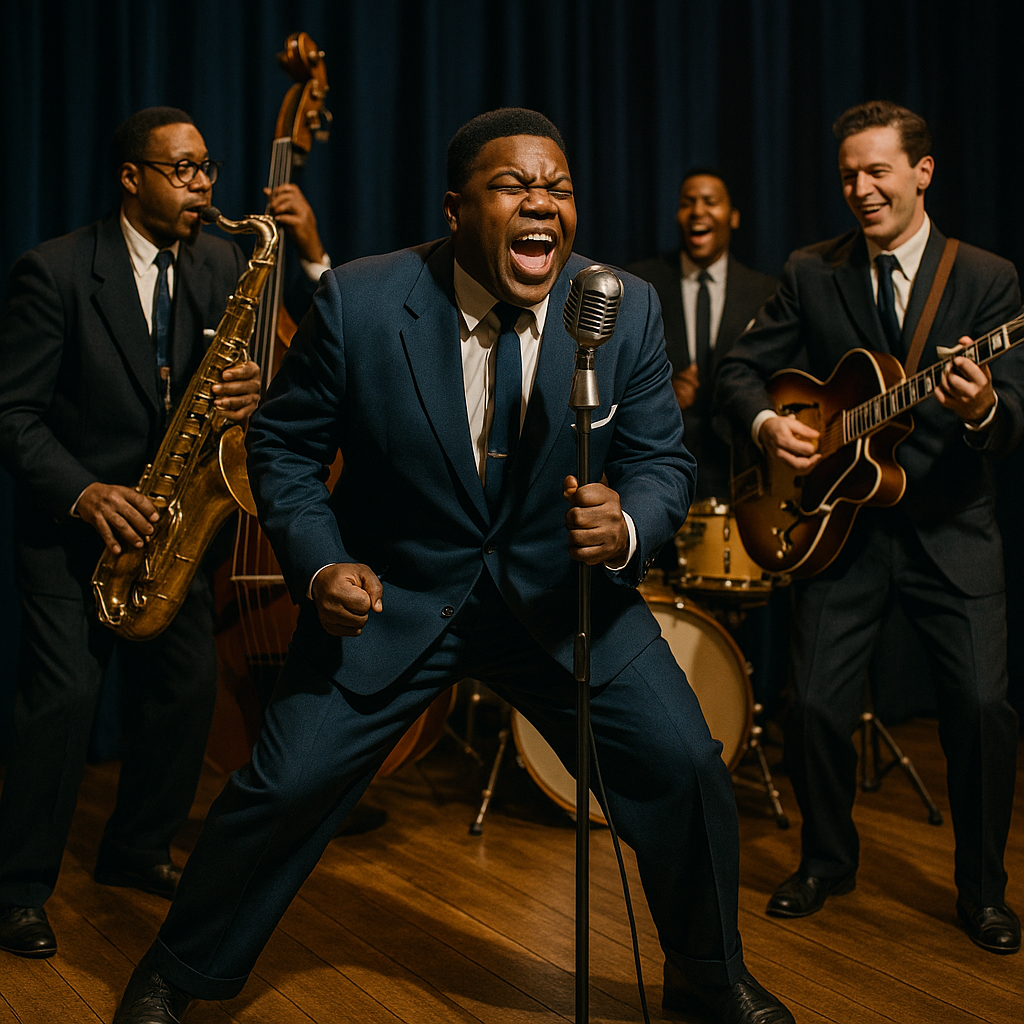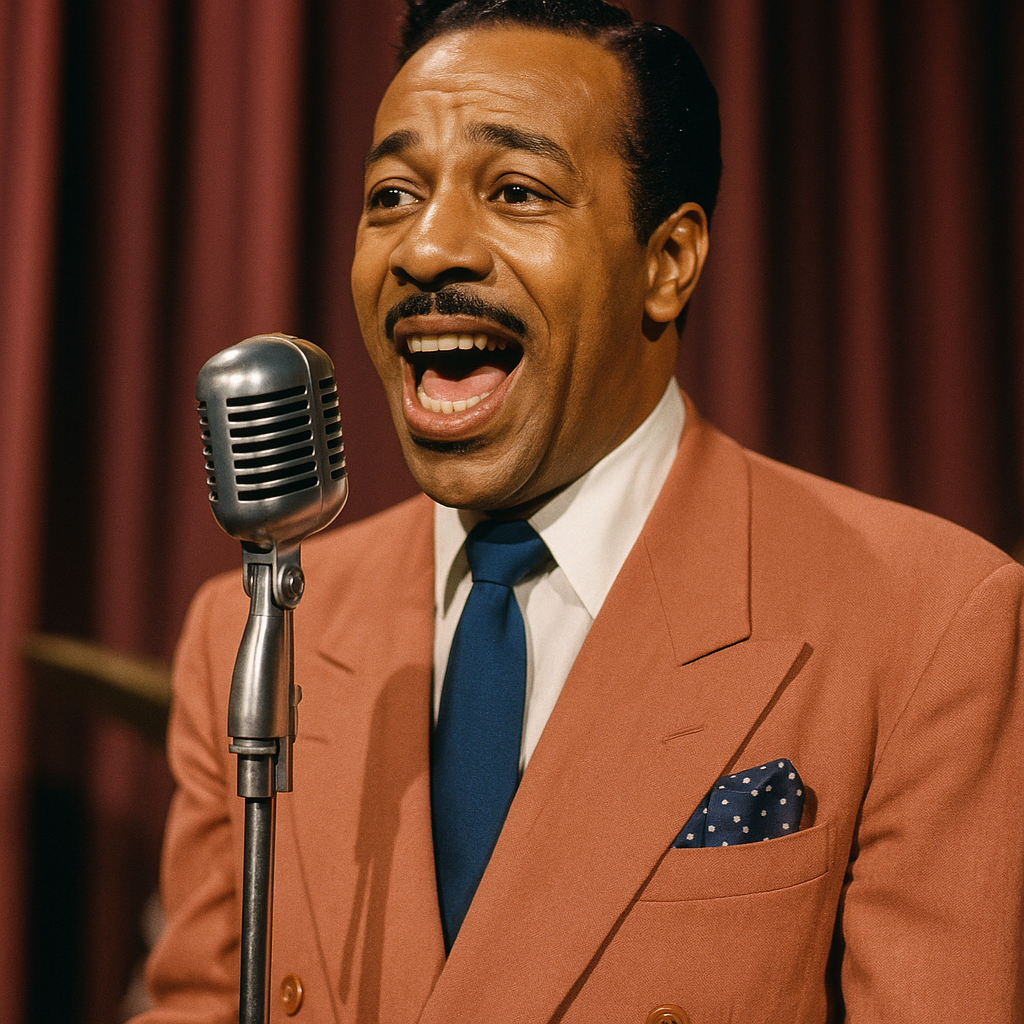Introduction: The King of the Shouters
Jump Blues was the 1940s version of rock and roll, and Wynonie Harris was one of its leading performers. A master showman with a powerful voice and larger-than-life personality, Harris was known as the “Mr. Blues” of the jump blues genre. Audiences were captivated by his high-energy stage presence, brash and lascivious lyrics, and foot-stomping rhythms.
It was no accident that Wynonie was dubbed “The King of the Shouters.” The Nebraska-born singer could sing circles around most musicians, dance the night away, and out-play and out-perform nearly everyone on stage. By incorporating big band swing and early rock and roll, Harris carved a musical niche that created a unique sound.
Before Elvis thrust that pelvis, Wynonie was shaking hips and getting those wild juices flowing with “wild one” anthems. He laid the groundwork for rock music to explode. Loud and proud, Wynonie Harris was hip to it all before it was cool.
In this post, you will discover the story of Wynonie Harris and his contribution to the jump blues genre. We will take a look at his early years, musical influences, performance style, and most popular songs. We will also examine his legacy and impact on later artists and modern music.
Early Life and Musical Roots
Wynonie Harris was born in Omaha, Nebraska in 1915. The youngest child of a single mother, Harris grew up in the working-class neighborhoods of Omaha. He was raised in a musical household and the gospel music of the church left an early impression on Harris.
During his youth, Harris worked a series of odd jobs, shining shoes, selling papers and the like. But Harris also kept a sharp eye on the world of entertainment. His personality, self-confidence and resonant baritone voice set him apart from the other children in his neighborhood.
Harris began to find work as a singer in clubs and theaters, where he learned to perform and capture an audience. He mixed comedy, rhythm and muscle in his performances and developed an early taste for the kind of jump blues that would make him famous.
Harris was influenced by all the music he heard during the 1930s. Blues, swing and jazz filled the radio and dance halls. Performers such as Louis Jordan and Big Joe Turner helped Harris develop his feel for rhythm and entertainment.
Harris also learned by watching the audiences that he was eventually performing for. He learned what worked on the dance floor and what made people holler. He also learned the black vaudeville and black theater traditions that would add color to his work.
Harris was a master entertainer and musician before he left Omaha. He had the stylistic range to cover the sounds of the day and his voice was gritty and deep. He also had a stage presence that was developed over a long period of time in black theaters and nightclubs.

Breaking Through: Lucky Millinder Years
By the early 1940s, Wynonie Harris had joined Lucky Millinder’s big swing band. Millinder was a bandleader with a proven track record. This association provided Harris with a high-profile platform to showcase his talents. Playing with the band brought him bigger stages and national attention.
The band’s most significant success was the 1945 hit “Who Threw the Whiskey in the Well”. Harris’s powerful vocals and energetic performance made the song an instant classic. It became a national sensation, climbing the charts and earning both Millinder and Harris widespread acclaim.
You can hear “Who Threw the Whiskey In the Well” here
Touring with Millinder’s band allowed Harris to perform all over the country. He was no longer a local singer at the Omaha club. Harris was a rising star. The excitement generated by his performances quickly caught the attention of record labels.
Solo offers came pouring in after the success of “Whiskey”. Harris’s charisma and vocal style were ideally suited to the postwar jump blues era. The hit not only made him a household name but also gave him the confidence to strike out on his own.
That moment with Millinder was a turning point in Harris’s career. He stepped into the spotlight and never looked back. His solo journey was about to begin, and the best was yet to come.
Jump Blues and Signature Style
Jump blues is a rhythmic, high-energy style of postwar rhythm and blues. Jump blues mixed big band swing with blues and boogie-woogie piano. Originating in the 1940s, jump blues played a significant role in shaping the early rock and roll sound, characterized by its propulsive rhythm and danceable beats.
Jump blues singer Wynonie Harris used a bold, shouting vocal style. He sang raw, loud, and brash. His vast, brassy voice was used to slice through a horn-and-drum section. He howled and bellowed the blues with a big sneer.
Harris’s lyrics were full of playful double entendres. Songs like “Good Rockin’ Tonight” or “Sittin’ on It All the Time” were bawdy, suggestive, and swaggering. Onstage, Harris matched his lyrics with flashy suits, greasy dance moves, and braggadocio.
You can hear “Sittin’ On It All the Time ” here
Like fellow jump blues shouter Big Joe Turner, Harris sang the blues with gospel-rooted intensity and showmanship. But while Turner was grittier and more traditional in the boogie and blues style, Harris added humor and flash. Both men were early pioneers of the singing style that would become characteristic of rock and roll vocalists.
You can read about Big Joe Turner here
Harris’s music fell between the poles of vaudevillian entertainment and street-corner blues grit. His braggadocio, comic asides, great rhythm, and powerful voice made Wynonie Harris a standout in jump blues.

Hit Records and Chart Success
Wynonie Harris had a string of hit records from 1948 to 1952. He was known for his hard-driving blues and boogie-woogie style. His raspy voice and charismatic stage presence set him apart from other R&B singers at the time.
In 1948, he released the single “Good Rockin’ Tonight”. It became a big R&B hit, reaching number one on the Billboard R&B chart. The song’s driving beat, suggestive lyrics, and sassy vocal performance made it a classic in the genre.
The success of “Good Rockin’ Tonight” opened the door for Harris to have many more R&B hits. Many of his songs, such as “All She Wants to Do is Rock” and “Sittin’ on It All the Time”, became jukebox standards. His records continued to have a strong appeal to both black and white audiences.
You can hear “All She Wants To Do Is Rock” here
Harris had several more Top Ten R&B hits during this time, including the double-sided hit “Blow Your Cool” and “All She Wants to Do is Rock.” His energetic and risqué style made him one of King Records’ most successful artists during this era.
Wynonie Harris had a string of hits during the late 1940s and early 1950s. His lively, suggestive R&B style made him a popular artist, and his records often sold well across racial lines. Although he had many popular records, none of them reached the number one spot on the Billboard R&B chart.
Influence on Rock and Roll
Wynonie Harris is a legendary artist who played a vital role in pioneering the early sound of rock and roll. His music mixed elements of jump blues, swing, and unbridled energy, helping to create a new sound.
He popularized the up-tempo, driving rhythms and raucous lyrics that would later define rock and roll. Songs like “Good Rockin’ Tonight” became anthems of the early rock and roll era.
Elvis Presley famously covered his song “Good Rockin’ Tonight” in 1954. This is only one example of how Harris’s music influenced the development of rock music beyond the R&B charts.
Harris’s loud, gritty voice and swaggering stage presence became a template for rock and roll vocalists. His style influenced future performers like Little Richard and Chuck Berry.
He brought swagger and showmanship to his live performances, full of confidence, humor, and suggestive charisma, appealing to a broad audience.
Lyrically, he pushed the boundaries of what was considered acceptable for the time with his suggestive double entendres and sexual bravado. This became a hallmark of early rock and roll music.
His work bridged the gap between 1940s swing-era blues and the rock music of the 1950s, with its shuffle beats, saxophone solos, and shout-singing.
Wynonie Harris’s music made the blues sound danceable and rebellious, passing the torch to the new wave of rock and roll pioneers.
Wynonie Harris is a crucial but often underappreciated link in the blues-to-rock and roll chain. He helped set the stage for a musical revolution. Rock and roll wouldn’t have sounded the same without his jump blues influence.
Persona, Style, and Stage Presence
Wynonie Harris strutted about in fancy outfits, slicked shoes, and a showboating gait. Offstage, he was as flashy as his wardrobe, known to be a ladies’ man.
Onstage, he was a force to be reckoned with. He pranced around, told jokes between songs, and had his way with the stage. Crowds howled and danced to his every command.
His act was sprinkled with comedic interludes of ribald storytelling and taunts. He gave his performances a vaudeville quality with a side of innuendo.
Fans, especially younger ones, adored his rebellious persona. He had no qualms about pushing limits vocally or sexually.
In many ways, Harris laid the groundwork for rock performers to follow. His over-the-top theatrics would later be reflected in the stage acts of Little Richard, James Brown, and Elvis Presley
Career Decline and Final Years
By the late 1950s, Harris’s style had fallen out of favor. Rock and roll music had changed, and many of its early stars were now considered outdated.
Newer, younger artists were the focus of the music industry, and Harris’s music now seemed old-fashioned. His record sales declined, and he no longer had many chart-topping hits.
Wynonie Harris also struggled with alcoholism, which further damaged his career and health. His voice became weaker, and he began to lose some of his singing opportunities.
Despite his troubles, Harris continued to perform into the 1960s. He continued to play in small clubs, delivering energetic performances for his fans.
In 1969, Harris passed away from throat cancer. He was 53 years old. His final years had been difficult, but his contribution to music was never forgot.
Legacy and Cultural Impact
Wynonie Harris’s recordings contributed to jump blues becoming an amplified, rambunctious style. His vocal shouting, comical lyrics, and beats are a starting point for what would come in rock and roll music.
His impact was so widespread, but he has never had a long term mass appeal. Elements of his music were mimicked by younger generations, but history has largely forgotten his name.
Rock and roll historians and blues enthusiasts have kept his name alive. His music is repackaged and reevaluated, as historians attempt to connect the dots between swing music, jump blues and rockabilly.
Harris can be seen as a bridge between cultures. He took big band swing and amplified it with the urban blues, and became a major contributor in creating the music that we now know as rock and roll.
Conclusion: Why Harris Still Matters
Wynonie Harris brought bold energy, raw vocal power, and humor to postwar blues. He helped shape the rise of rock and roll’s rhythm and spirit.
His records still burst with life, attitude, and grit. Listeners today can feel his influence in rock, R&B, and soul.
Harris deserves recognition as a trailblazer who bridged the gap between swing, blues, and early rock. His voice and style continue to inspire.
Revisit his songs and witness a pioneer in action. His legacy lives on in every shouted lyric and pounding beat.
